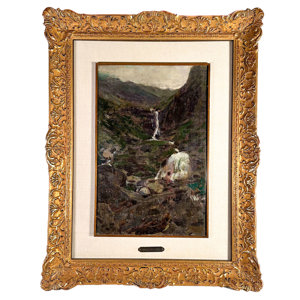Guglielmo Ciardi was born in 1842 in Venice, after his classical studies attended the Academy of Fine Arts, where he attended courses taught by F. Moja. When he left the Academy only two years later, he immediately proved his skill as a painter, anticipating the future style both from a technical and a content point of view. He visited Florence where he was introduced to the world of the macchiaioli; then Rome and Naples, but also Capri, Sorrento and Salerno, whose landscapes knew how to portray in a balanced way, playing on the contrast of shapes and colors. On his return to Venice in 1869, he married Linda Locatelli, who gave him four children.
He will continue to visit often the cities where he had traveled as a young man. Despite having learned a lot from the various local painters, Ciardi's style will gradually become detached from the Neapolitan and Florentine motifs to sum up an exquisitely Venetian sincerity. His technique and the light and bright colors make a perfect image of the lagoon, and many of the paintings of the period deserved the admiration of the most severe critics of the time. In the last period the artist tends to search for simpler and more refined styles, yet this does not affect the quality of the work (the masterpiece Messidoro is dated 1883), thanks to which Ciardi receives prestigious prizes.
Moving the attention to the new subject of the Treviso countryside, the artist refines his attention to detail and detail, and builds endlessly prolonged plans, shining with golden light. Since 1885, for the long walks in the mountains, the subjects of Ciardi change again, and style with them: however this unusual technique marks the beginning of his artistic decadence , increasingly visible when, at the beginning of the century, he completely abandoned his style in the hope of attracting the favor of a wider audience. Before his death in October 5, 1917, in his hometown, will regret this choice and will resume the style of the past.



 Text via WhatsApp
Text via WhatsApp